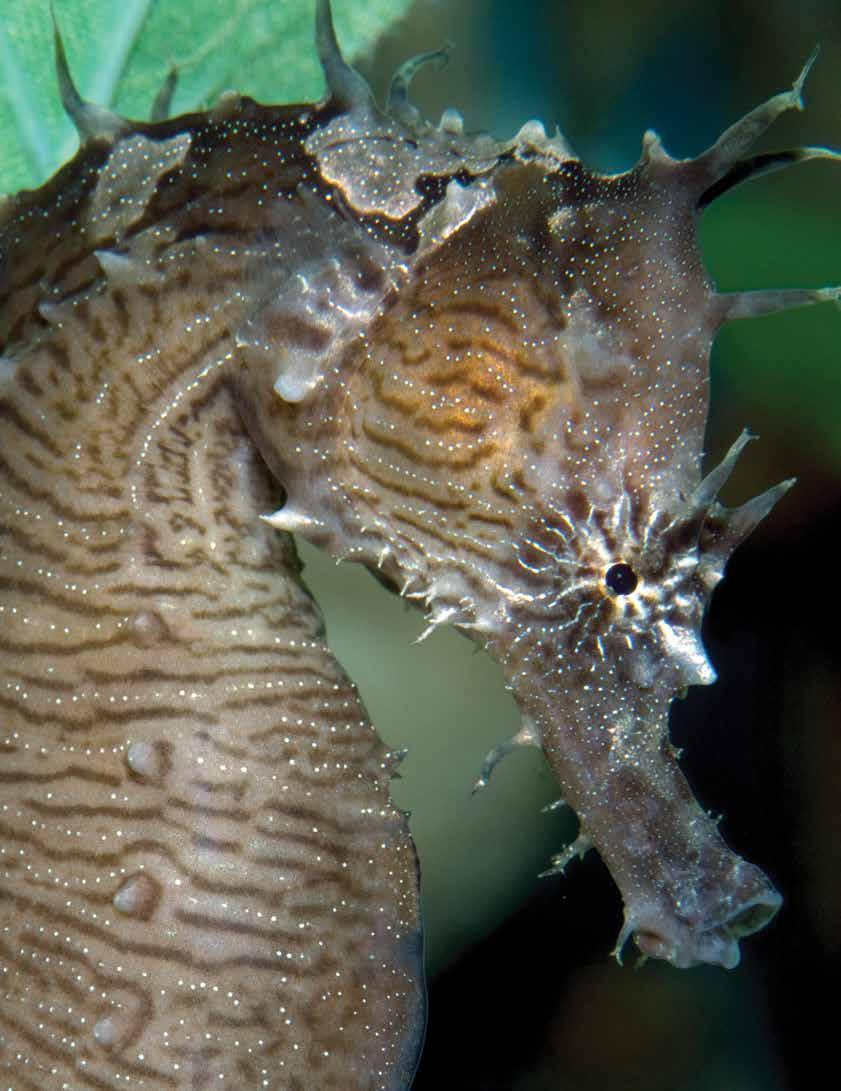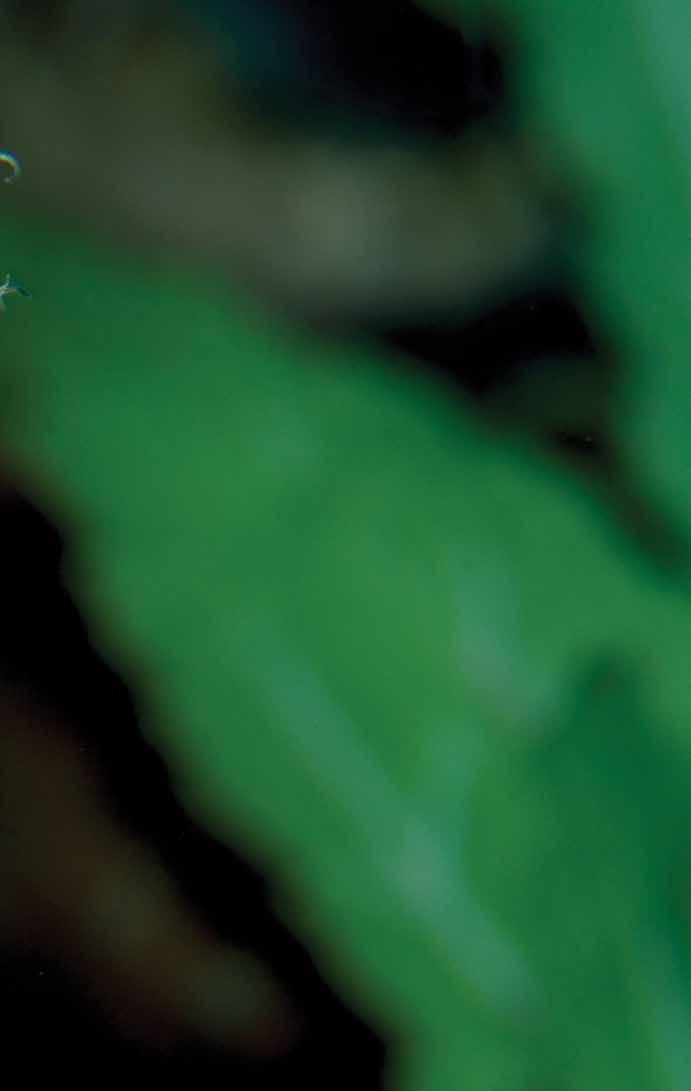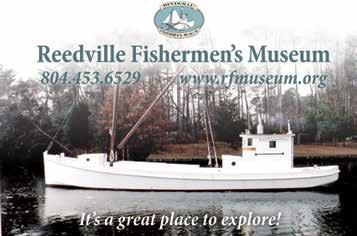
8 minute read
Seahorses of the Chesapeake Bay
OF THE CHESAPEAKE BAY Seahorses
Advertisement
Iwas mesmerized when I saw my first seahorses as a child. Exotic and ephemeral, they floated quietly in a tank of turquoise blue amid strands of sea green kelp. They bespoke of warm tropical seas and ancient myths and legends. For more than 2,000 years, sculptures, frescoes, paintings, jewelry and mosaics have depicted seahorses in imaginative ways.
Poseidon, the Greek god of the sea, called Neptune by the Romans, traveled in a chariot drawn by fierce steeds, each with the head of a horse and the tail of a fish. Homer’s Iliad describes a vengeful Poseidon emerging from the waves, driven forth in a chariot drawn by plunging seahorses.
The ancient world glorified these fish, from winged seahorses and Tritons in Rome’s fabled Trevi Fountain to bronze lamp posts illuminating Dublin’s Grattan Bridge. A stunning gold broach, fashioned by a master craftsman from the sixth century Lydian culture, was placed in a royal tomb and never saw the light of day until discovered in the 1960s. The ancient British Isles abounds with seahorses; from the famous Roman baths in Bath, England with its stunning seahorse mosaics to Scotland, where the Picts carved beautiful, mythical kelpies in sandstone.
Across the Baltic sea, Scandinavia’s “havhest,” a huge seahorse-serpent, could breathe fire and sink ships. Australia’s Rainbow Serpents symbolize the cycles of the seasons among Aboriginal tribes. Then on into Mexico, where a fat seahorse prankster was finally driven into the sea by its exasperated neighbors and forced to live there forever. Worldwide, seahorses have captured man’s imagination.
Seahorse myths imbued them with medicinal powers too. Ancient Greek and Roman apothecaries mixed seahorses with goose fat as a salve that they claimed would restore a full head of hair on a bald scalp. Pliny the Elder wrote that seahorses could cure rabies, leprosy, urinary incontinence and fevers. Eat a seahorse, Roman author Claudius Aeolian said, and you will spend the rest of your life drawn to the soothing sounds of moving water. He warned, however, that a seahorse boiled in wine was a deadly poison. Hollywood has done its fair share depicting seahorses as chariot and mermaid steeds plying through mystical lands beneath the sea. Aquaman, the Littlest Mermaid and Finding Nemo have all paid homage. They remain as mysterious as fairies, mermaids and dragons. If we are lucky, we might catch By Deb Weissler



glimpses of them in aquariums large and small or spot them while wearing snorkels and masks swimming in exotic locales. What I did not expect to see was a seahorse tossed up on Haven Beach in Mathews County one warm summer day.
As beachcombers, it’s rarely about the view. It’s what lies at our feet that matters. Among the broken shells and pebbles lay a tiny lined seahorse, Hippocampus erectus, as it is known by scientists. With a head that resembles a horse, eyes like a chameleon, bony armor plates, and a prehensile tail like a monkey’s, this minuscule creature was a far cry from those mighty steeds de- picted in legends. Wondrous nevertheless. Of the more than 54 species of sea- horses worldwide, only one resides in the Chesapeake Bay.
“It’s just the way the oceans developed and evolution took place,” explains Vir ginia Institute of Marine Science Associate Research Scientist Dr. Troy Tuckey. “The area with the greatest diversity of fishes is in the Indo-Pacific region, the Pacific being the oldest ocean in the world. The Atlantic, by comparison, is relatively young so only one species developed in our region. Perhaps there were once other species that were outcompeted; it’s hard to say.”
Despite that, the lined seahorse, also known as the northern or spotted seahorse, inhabits a broad range, from as far north as Nova Scotia and as far south to Venezuela. It can tolerate a broad range of tempera- tures and varying degrees of salinity. Lined seahorses have been found in lower tidal estuaries to deep ocean, enabling them to live in a variety of habitats, including the middle and lower Chesapeake Bay.
In warm weather, seahorses can be found in shallow estuaries, salt marshes and oyster beds along coastal beaches. Adults can be spotted swimming freely or attached by their tails to stationary objects such as seagrass, sponges, and even crab pots. In winter, they migrate to deeper waters.
Rings of bony plates, ranging in color from pale yellow to black, contain dark lines that appear on its head, neck, and back, giving it its name. Its horse-like head is held erect, and its long, toothless snout serves to suck in tiny crustaceans, mollusks and zooplankton. With some anatomical resemblance to a serpent, the seahorse coils in wait for its next meal, striking fast like a snake.
Although not a strong swimmer, its


Three-inch seahorse found washed up on Haven Beach. Photo by Deb Weissler

Lined seahorse grasps a scientist’s thumb during a trawl survey. Photo courtesy of VIMS.

Trevi Fountain



small dorsal fins enable the seahorse to hover, dart and maneuver. Its eyes can function in sync or independently. Its prehensile tail, more often associated with mammals, can attach and hang onto objects and it is the only fish known to have this feature. Despite this odd as- semblage, the seahorse conveys beauty and grace.
In the bay they may grow to seven inches long and reach sexual matu- rity from four to eight months. This is where the seahorse again diverges from other fish; it is the male who gives birth. The female lays her eggs in the male’s kangaroo-like brood pouch located on his belly. Here the eggs are fertilized and incubate for approximately two weeks, at which time a cloud of hundreds of fully formed seahorses, less than one-quarter inch long, emerge. Renewed courtship between the parents begins immediately after birth and seahorses will continue to mate and spawn through the warm months.
One modern myth claims that seahorse couples mate for life. Among seahorses held in captivity, reactions interpreted as deep mourning have been observed. Although it is true the surviving mate may not look for another automatically, their lifespan is so brief that it’s more likely they lack the oppor tunity to establish a bond with another before they too die. The myth endures nevertheless.
There are more than 180 species of animals in the Chesapeake Bay, and sci- entists tend to concentrate on those with greatest economic value to watermen and the state’s economy. Seahorses in the bay have not been intensely studied, although their numbers are monitored by way of VIMS monthly multi-species trawl surveys conducted on the Virginia portion of the Bay and the James, Rappa - hannock and York Rivers. VIMS typically finds 40-100 seahorses a year.
VIMS trawl studies began in 1955. Changes in trawl nets have enabled sci- entists to improve catch-ability of small fishes. “We’ve been fairly consistent in numbers since 1988,” Tuckey points out, “so we can provide a trend as to numbers from that point on. Our seahorse catches increase during April and stay relatively similar through November, after which they drop off and are low until the fol - lowing April. We have a quarter-inch
mesh liner that goes inside the tail or cod end of the net that helps capture the really small fish. We only trawl for five minutes and in that time capture enough small fishes to conduct our surveys. Catches are separated by species, measured, counted, and released. We sample about 1,224 stations per year. Our surveys of fishes, blue crabs and shrimp provide various management agencies in charge of commercial and recreational species a heads up in projecting the abundance or lack of the various fishes that are managed.”
Seahorses are preyed upon by anything with a mouth large enough to ingest them, but they are not normally targeted because they don’t have much meat and their bony plates make them tough. They are also masters at camouflage and stealth, making them ex ceedingly hard to spot. Sadly, outside of the Chesapeake Bay, seahorses are threatened worldwide. In addi
tion to habitat loss due to coastal growth and pollution, an estimated 20 million are taken as by-catch by shrimpers each year. Ornamental decorations in the tourist industry and the aquarium trade have caused seahorse numbers to fall by as much as 30 percent since 1996, when changes in population were first noted.
The demand for seahorses to be used in Chinese medicine and teas continues to rise. In India, dried seahorses are mixed with honey and used to treat whooping cough. Indonesians use seahorses in medicine to treat rheumatism, memory loss and impotence. In Japan, they are believed to be a potent aphrodisiac, and fishing communities throughout Southeast Asia burn seahorses and sprinkle their ashes over fishing nets to bring good fortune.
Some large aquariums are breeding seahorses in captivity with some success, providing smaller facilities with captivebred animals rather than taking them from the wild. But some species have not reproduced in captivity and mortality is high for others. In the future, these animals may be suitable for aquaculture, providing sufficient numbers to protect those remaining in the wild.
You may never see a seahorse in the wild or find one washed up on local beaches. Until you see one for yourself, it’s easy to imagine seahorses as mighty steeds of old, pulling Poseidon’s chariot across the waves. The incredible stories that have sprung up around these enigmatic creatures continue even today. As dwellers of the Chesapeake Bay region, we are fortunate to have our own lined seahorses living in our own little corner of the world. H










